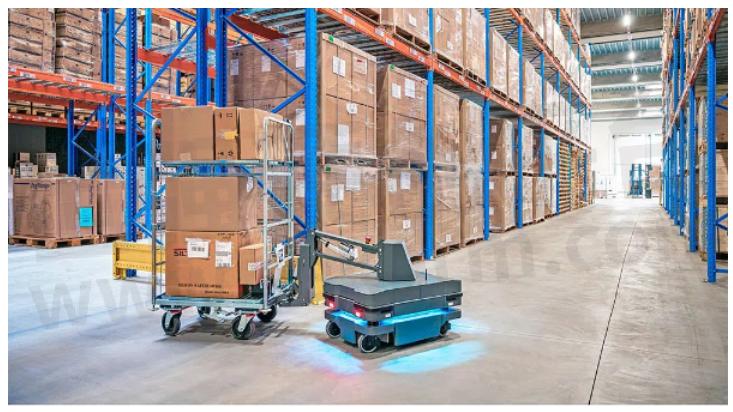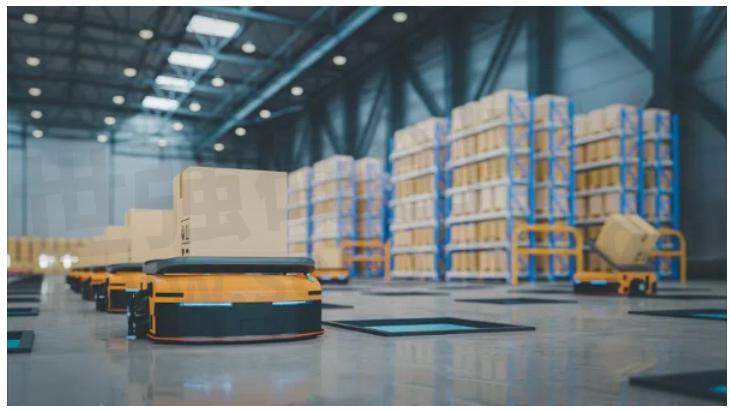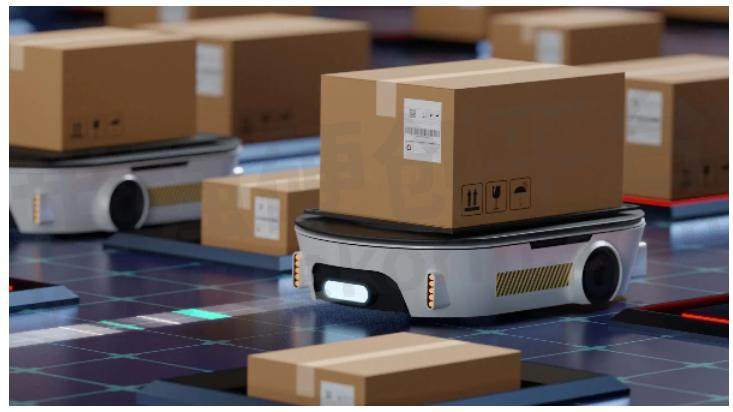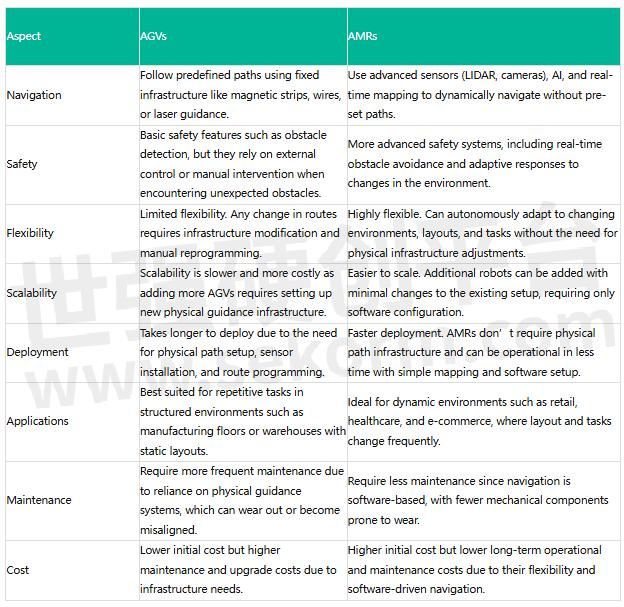What Batteries are Used for AGVs and AMRs?




The world of material handling and logistics has been transformed by automation, with Mobile Industrial Robots (MIRs) playing a pivotal role in improving efficiency. Two common types of MIRs are Automated Guided Vehicles (AGVs) and Autonomous Mobile Robots (AMRs). While both serve similar functions—transporting materials, assisting in warehouses, and enhancing workflows—they differ significantly in terms of navigation technology and autonomy. This article explores the differences between AGVs and AMRs, focusing on the types of batteries that power these innovative machines.
What is a Mobile Industrial Robot (MIR)?
Mobile Industrial Robots (MIRs) are self-driven vehicles that transport materials in industrial environments. They operate without human intervention, designed to autonomously navigate through warehouses, manufacturing facilities, or distribution centers. MIRs improve productivity, reduce the need for manual labor, and increase the overall efficiency of logistical operations. These robots are typically used in industries like manufacturing, logistics, and e-commerce, where the automation of tasks such as material transport is crucial for operational success.

MIRs can be divided into two primary categories based on their level of automation and flexibility:
●Automated Guided Vehicles (AGVs)
●Autonomous Mobile Robots (AMRs)
Both AGVs and AMRs serve similar roles but differ in terms of how they navigate, their capabilities, and the environments they are best suited for.
What is an AGV?
Automated Guided Vehicles (AGVs) are mobile robots that follow predefined paths in a controlled environment. These paths are typically set using magnetic strips, sensors, or lasers. AGVs are widely used in warehouses, factories, and distribution centers for transporting materials along fixed routes. They offer reliable, repeatable performance, making them ideal for structured environments where consistency is crucial. AGVs lack the ability to dynamically adapt to new obstacles or changes in their environment. This means that any deviation from their path, such as encountering an obstacle, could lead to a halt in operation until the obstacle is removed or the path is cleared.

How to Power AGVs?
AGVs rely on battery power for mobility, and the type of battery chosen can directly affect their performance, efficiency, and operational lifespan. Typically, AGVs use the following types of batteries:
Lead-Acid Batteries
Traditionally used in AGVs due to their low cost.
They offer reliable performance but have a shorter lifespan and require more maintenance, such as regular watering.
Slow charging times can result in increased downtime.
Lithium-Ion Batteries
Becoming the more popular choice due to their longer lifespan, faster charging times, and maintenance-free nature.
They can handle more charge-discharge cycles compared to lead-acid batteries.
Higher energy density allows for longer operation periods without recharging, improving efficiency.
Nickel-Cadmium (NiCd) Batteries
Less common but still used in some AGVs for applications requiring rugged, reliable performance in challenging conditions.
NiCd batteries are durable but suffer from a memory effect, reducing their long-term effectiveness.
What is an AMR?
Autonomous Mobile Robots (AMRs) are more advanced than AGVs, capable of navigating complex and dynamic environments without predefined paths. In contrast to AGVs, autonomous mobile robots move independently through their environment and act in real-time thanks to digital warehouse maps paired with cutting-edge sensors and AI that allow them to independently detect obstacles and avoid them. The increased autonomy of AMRs makes them more versatile than AGVs, allowing them to work in various industries, including retail, healthcare, and logistics.

How to Power AMRs?
Similar to AGVs, AMRs depend on rechargeable batteries for continuous operation. However, the demands of AMRs, such as higher computational needs and longer working hours, make energy efficiency and power longevity even more critical. The following battery types are typically used for AMRs:
Lithium-Ion Batteries
The most common choice for AMRs due to their high energy density, long operational life, and rapid charging capability.
They allow AMRs to operate for extended periods without downtime.
Maintenance-free, which makes them ideal for operations requiring 24/7 uptime.
Solid-State Batteries
A newer and emerging technology that promises higher energy density, longer life, and improved safety over traditional lithium-ion batteries.
While not widely adopted yet, solid-state batteries may become a future standard for powering AMRs as their technology matures.
Supercapacitors
Occasionally used alongside traditional batteries to provide quick bursts of energy, useful for robots that require rapid acceleration or energy-intensive operations.
While not a primary power source, they complement batteries to improve the overall performance and efficiency of AMRs.
AGVs vs AMRs: What's the Difference?
Usually, AGVs are more suited for environments with structured, repetitive tasks where consistency is key, but they come with limitations in terms of flexibility and scalability. However, AMRs excel in dynamic environments where adaptability, faster deployment, and future scalability are essential, making them the more flexible but costlier option initially. Here’s a comparison table that highlights the differences between AGVs and AMRs across six key aspects:

What Batteries Are Used for AGVs and AMRs?
Both AGVs and AMRs rely on rechargeable batteries to power their movement, sensors, and other functionalities. While traditional lead-acid batteries were once the standard for AGVs, the industry is rapidly shifting toward lithium-ion batteries due to their superior energy density, faster charging times, and longer lifespans.
For AMRs, lithium-ion batteries remain the most popular choice due to their high energy demands and the need for extended operational times. The emerging technology of solid-state batteries may also soon play a key role in powering AMRs, offering higher efficiency and safety.
Ultimately, the choice of battery depends on the specific application, cost considerations, and the operational demands of the robot. However, as technology advances, both AGVs and AMRs are moving towards more energy-efficient, sustainable, and long-lasting power solutions, driving the future of automation in material handling.
Conclusion
AGVs and AMRs represent the future of automation in logistics and manufacturing. With AGVs offering structured, reliable performance and AMRs delivering flexibility and autonomy, these mobile industrial robots are revolutionizing the way materials are handled. The choice of battery plays a crucial role in their performance, and as the industry evolves, we can expect to see further innovations in battery technology that will enhance the capabilities of both AGVs and AMRs. As a global leading lipo battery manufacturer, Grepow offers high-energy-density semi-solid state batteries and lipo batteries that perfectly meet the needs of AGVs and AMRs. If you have any questions or needs, please feel free to contact us at info@grepow.com.
- |
- +1 赞 0
- 收藏
- 评论 0
本文由雪飘梦飞转载自Grepow Official Website,原文标题为:What Batteries Are Used for AGVs and AMRs?,本站所有转载文章系出于传递更多信息之目的,且明确注明来源,不希望被转载的媒体或个人可与我们联系,我们将立即进行删除处理。
相关研发服务和供应服务
相关推荐
Can Lipo Battery Cells Be Shipped by Air?
With the widespread use of electronic products, batteries nowadays have become household items that we can see everywhere. The most commonly encountered type of battery is the lithium-ion battery.
What Is a 6S LiPo Battery?
Lithium Polymer (LiPo) batteries are widely used in drones, RC vehicles, and various other applications due to their lightweight, high energy density, and power delivery. Among these, 6S LiPo batteries are particularly popular. This guide explores their specifications, types, and applications.
An In-Depth Guide to Drone Motors
Drone motors come in a variety of types and configurations, each with unique advantages. Understanding how each motor type functions, along with key specifications like KV rating, thrust, and ESC compatibility, is essential in selecting the right motor. As drone technology continues to evolve, motor advancements will likely play a pivotal role in achieving higher efficiency, greater power, and more specialized functionality across a wide range of drone applications.
Gens ace Advanced Series begins a new generation of RC smart battery
Gens ace Advanced series batteries are the next generation of RC batteries. The Advanced series design concept is based on being a more convenient, user-friendly, and safety-oriented series of batteries. All Gens Ace Advanced series batteries are equipped with GREPOW factory-made components.
Tips for maintenance and emergency disposal of agriculture drone battery
In this article, Grepow talks about how the agriculture drone battery is daily maintained, and how to dispose of it when there is an emergency.
Energy Storage Market for UAVs by Product and Geography - Forecast and Analysis 2022-2026
The “Energy Storage Market for Unmanned Aerial Vehicles (UAVs) by Product and Geography - Forecast and Analysis 2022-2026“ report has been added to Technavio‘s offering.
Grepow covers a wide range of shaped batteries to maximize the use of product space, perfectly adapted to small portable electronic products
Grepow covers a wide range of shaped batteries: round lipo batteries, C-shaped batteries, curved lipo batteries, hexagonal batteries, fan-shaped batteries, triangular batteries, ultra-thin batteries, etc., to maximize the use of product space, perfectly adapted to small portable electronic products.
Prescription vs OTC Hearing Aids: What‘s the Difference?
If you value convenience, long-term savings, and eco-friendliness, rechargeable hearing aids could be the better choice. However, if you prefer a lower upfront cost and the simplicity of changing batteries without worrying about charging, disposable battery models might be more suitable. Both options are available in prescription and OTC hearing aids, so you can make a choice that best suits your lifestyle and hearing needs.
How Drone Light Shows are Created and Key Battery Power Requirements
This paper mainly introduces the application of Grepow‘s battery products in Drone Light Shows, and introduces the battery requirements for the application of drone light shows.
Grepow Custom Lipo Battery Pack Solutions for Consumer Electronics, Drones, UAVs, EVs and So on
Grepow‘s custom Lipo Battery Pack solutions offer unmatched flexibility, performance, and safety for a wide range of applications. By leveraging advanced technology and extensive customization options, Grepow ensures that each battery pack is tailored to meet the specific needs of its customers. Whether for consumer electronics, drones, electric vehicles, or industrial equipment, Grepow‘s LiPo battery packs provide reliable, high-performance power solutions.
How to Choose LiPo Battery for Drone?
In the world of drones, the right battery can make all the difference. Lithium Polymer (LiPo) batteries have become the go-to choice for drone enthusiasts and professionals alike, thanks to their high energy density, lightweight construction, and ability to deliver high discharge rates. If you‘re new to the drone scene or looking to upgrade your current setup, here‘s everything you need to know about LiPo batteries for drone.
Grepow 3.7V 40mAh LiPo Curve Shaped Battery 2508030
GREPOW is a high-technology lithium-polymer battery specialist who is capable of providing fully integrated battery solutions to power wide range of electronics equipment. When the dimension and weight of electronics is critical, GREPOW’s special shape batteries are proven to deliver good durability and reliability, outstanding performance and long cycle life for fast-growing smart, mobile and wearable electronics.
Round LiPo Battery: A Comprehensive Guide
Round LiPo batteries offer a versatile and efficient power solution for a wide range of applications. With their compact design, high energy density, and customizable features, they are an excellent choice for modern electronic devices and specialized equipment. Grepow‘s innovative solutions further enhance the potential of round LiPo batteries, making them a reliable option for various industries.What is a Round LiPo Battery?A round LiPo battery, or round lithium polymer battery, is a type of rechargeable battery with a circular shape.
What Is a Semi-Solid State Battery?
Semi-solid state batteries are a type of rechargeable battery that uses a semi-solid electrolyte instead of the liquid or gel electrolytes found in traditional lithium-ion batteries. The semi-solid electrolyte is typically composed of a solid, conductive material suspended in a liquid electrolyte. This unique composition offers several advantages over conventional battery designs.
How Are Smart Rings Powered?
Smart rings are powered by efficient, rechargeable batteries and designed with energy-saving technologies, they provide a balance of performance and convenience. As a global leading lipo battery manufacturer, Grepow can provide extremely narrow smart ring batteries, as thin as 1.4mm and as narrow as 4.5mm, to meet the design requirements of various innovative smart rings.
电子商城
服务
可自由定制电池形状,锂离子聚合物/磷酸铁锂成分,放电倍率Max. 50C (持续放电倍率) / 150C (脉冲放电倍率),充电倍率:Max. 5,厚度可达0.5mm。
最小起订量: 5000 提交需求>






































































































































































































登录 | 立即注册
提交评论